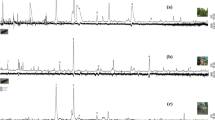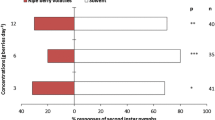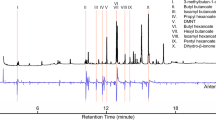Abstract
Codling moth, Cydia pomonella L. (Lepidoptera: Tortricidae), is a major cosmopolitan pest of apple and other pome fruits. Ethyl (E,Z)-2,4-decadienoate (pear ester) has been identified as a host-derived kairomone for female and male codling moths. However, pear ester has not performed similarly in different fruit production areas in terms of the relative magnitude of moth catch, especially the proportion of females caught. Our work was undertaken to identify host volatiles from apples, and to investigate whether these volatiles can be used to enhance the efficacy of host kairomone pear ester for monitoring female and male codling moths. Volatiles from immature apple trees were collected in the field using dynamic headspace sampling during the active period of codling moth flight. Using gas chromatography-electroantennogram detector (GC/EAD) analysis, six compounds elicited responses from antennae of females. These compounds were identified by GC/mass spectrometry (MS) and comparisons to authentic standards as nonanal, (E)-4,8-dimethyl-1,3,7-nonatriene, methyl salicylate, decanal, (Z,E)-α-farnesene, and (E,E)-α-farnesene. When the EAD-active compounds were tested individually in the field, no codling moths were caught except for a single male with decanal. However, addition of (E)-4,8-dimethyl-1,3,7-nonatriene, methyl salicylate, decanal, or (E,E)-α-farnesene to pear ester in a binary mixture enhanced the efficacy of pear ester for attracting female codling moths compared to pear ester alone. Addition of the 6-component blend to the pear ester resulted in a significant increase in the number of males attracted, and enhanced the females captured compared to pear ester alone; the number of males and females caught was similar to that with the pear ester plus acetic acid combination lure. Our results demonstrate that it is possible to synergize the response of codling moth to host kairomone by using other host volatiles. The new apple–pear ester host kairomone blend should be helpful for monitoring female codling moth, and may provide the basis for further improvement of codling moth kairomone.




Similar content being viewed by others
References
Anfora, G., Tasin, M., De Cristofaro, A., Ioriatti, C., and Lucchi, A. 2009. Synthetic grape volatiles attract mated Lobesia botrana females in laboratory and field bioassays. J. Chem. Ecol. 35:1054–1062.
Ansebo, L., Ignell, R., Lofqvist, J., and Hansson, B. S. 2005. Responses to sex pheromone and plant odours by olfactory receptor neurons housed in sensilla auricillica of the codling moth, Cydia pomonella (Lepidoptera: Tortricidae). J. Insect Physiol. 51:1066–1074.
Bäckman, A.-C., Bengtsson, M., Borg-Karlson, A.-K., Liblikas, I., and Witzgall, P. 2001. Volatiles from apple (Malus domestica) eliciting antennal responses in female codling moth Cydia pomonella (L.) (Lepidoptera: Tortricidae): Effect of plant injury and sampling technique. Z. Naturforsch. C 56:262–268.
Barnes, M. M. 1991. Codling moth occurrence, host race formation, and damage, pp. 313–327, in L. P. S. Van Der Geest and H. H. Evenhuis (eds.), Tortricid Pests: Their Biology, Natural Enemies and Control. Elsevier Science Publishing Co., Inc, New York.
Brinton, F. E., Proverbs, M. D., and Carty, B. E. 1969. Artificial diet for mass production of codling moth, Carpocapsa pomonella (Lepidoptera: Olethreutidae). Can. Entomol. 101:577–584.
Bruce, T. J. and Cork, A. 2001. Electrophysiological and behavioral responses of female Helicoverpa armigera to compounds identified in flowers of African marigold, Tagetes erecta. J. Chem. Ecol. 27:1119–1131.
Bruce, T. J. A., Wadhams, L. J., and Woodcock, C. M. 2005. Insect host location: A volatile situation. Trends Plant Sci. 10:269–274.
Buttery, R. G., Light, D. M., Nam, Y., Merrill, G. B., and Roitman, J. N. 2000. Volatile components of green walnut husks. J. Agric. Food Chem. 48:2858–2861.
Byers, J. A., Lanne, B. S., Löfqvist, J., Schlyter, F., and Bergström, G. 1985. Olfactory recognition of host-tree susceptibility by pine shoot beetles. Naturwissenschaften 72:324–326.
Casado, D., Cemeno, C., Avilla, J., and Riba, M. 2006. Day–night and phenological variation of apple tree volatiles and electroantennogram responses in Cydia pomonella (Lepidoptera: Tortricidae). Environ. Entomol. 35:258–267.
Cha, D., Linn Jr., C. E., Teal, P. E. A., Zhang, A., Roelofs, W. L., and Loeb, G. M. 2011. Eavesdropping on plant volatiles by a specialist moth: Significance of ratio and concentration. PLoS One 6:e17033.
Coracini, M., Bengtsson, M., Liblikas, I., and Witzgall, P. 2004. Attraction of codling moth males to apple volatiles. Entomol. Exp. Appl. 110:1–10.
Dicke, M. 2000. Chemical ecology of host-plant selection by herbivorous arthropods: A multitrophic perspective. Biochem. Syst. Ecol. 28:601–617.
El-Sayed, A. M. 2013. The Pherobase: Database of Insect Pheromones and Semiochemicals. http://www.pherobase.com. Accessed 4 February 2013.
El-Sayed, A. M., Suckling, D. M., Wearing, C. H., and Byers, J. A. 2006. Potential of mass trapping for long-term pest management and eradication of invasive species. J. Econ. Entomol. 99:1550–1564.
El-Sayed, A. M., Suckling, D. M., Byers, J. A., Jang, E. B., and Wearing, C. H. 2009. Potential of “lure and kill” for long-term pest management and eradication of invasive species. J. Econ. Entomol. 102:815–835.
Hawkins, L. and Hilton, R. 2008. Commercial trials and implementation of codling moth mating disruption puffer program. Proceedings, 82nd Western Orchard Pest and Disease Management Conference, 9–11 January 2008, Portland, OR. Washington State University, Wenatchee, WA.
Honda, K., Omura, H., and Hayashi, N. 1998. Identification of floral volatiles from Ligustrum japonicum that stimulate flower-visiting by cabbage butterfly, Pieris rapae. J. Chem. Ecol. 24:2167–2180.
Ioriatti, C., Molinari, F., Pasqualini, E., De Cristofaro, A., Schmidt, S., and Espinha, I. 2003. The plant volatile attractant (E, Z)-2,4-ethyl-decadienoate (DA2313) for codling moth monitoring. Boll. Zool. Agrar. Bachic. 35:127–137.
Knight, A. L. and Croft, B. A. 1991. Modeling and prediction technology, pp. 301–312, in L. P. S. Van der Geest and H. H. Evenhuis (eds.), Tortricid Pests. Elsevier, Amsterdam.
Knight, A. L. and Light, D. M. 2005a. Factors affecting the differential capture of male and female codling moth (Lepidoptera: Tortricidae) in traps baited with ethyl (E, Z)-2,4-decadienoate. Environ. Entomol. 34:1161–1169.
Knight, A. L. and Light, D. M. 2005b. Timing of egg hatch by early-season codling moth (Lepidoptera: Tortricidae) predicted by moth catch in pear ester- and codlemone baited traps. Can. Entomol. 137:728–738.
Knight, A. L., Hilton, R., and Light, D. M. 2005. Monitoring codling moth (Lepidoptera: Tortricidae) in apple with blends of ethyl (E, Z)-2, 4-decadienoate and codlemone. Environ. Entomol. 34:598–603.
Knight, A. L., Haworth, J., Lingren, B., and Hebert, V. 2010. Combining pear ester with codlemone improves management of codling moth. IOBC/WPRS Bull. 72:145–149.
Knight, A. L., Light, D. M., and Trimble, R. M. 2011. Identifying (E)-4,8-dimethyl-1,3,7-nonatriene plus acetic acid as a new lure for male and female codling moth (Lepidoptera:Tortricidae). Environ. Entomol. 40:420–430.
Kutinokova, H., Subchev, M., Light, D. M., and Lingren, B. 2005. Interactive effects of ethyl (2E, 4Z)-2, 4-decadienoate and sex pheromone lures to codling moth: Apple orchard investigations in Bulgaria. J. Plant Prot. Res. 45:49–53.
Landolt, P. J., Suckling, D. M., and Judd, G. J. R. 2007. Positive interaction of a feeding attractant and a host kairomone for trapping the codling moth, Cydia pomonella (L.). J. Chem. Ecol. 33:2236–2244.
Leopold, E. J. 1990. Selective hydroboration of a 1,3,7-triene: Homogeraniol. Org. Synth. 64:164–171.
Light, D. M., and Knight, A. 2005. Specificity of codling moth (Lepidoptera: Tortricidae) for the host plant kairomone, ethyl (2E,4Z)-2,4-decadienoate: field bioassays with pome fruit volatiles, analogue, and isomeric compounds. J. Agric. Food Chem. 53:4046–4053.
Light, D. M., Knight, A. L., Henrick, C. A., Rajapaska, D., Lingren, B., Dickens, J. C., Reynolds, K. M., Buttery, R. G., Merrill, G., Roitman, J., and Campbell, B. C. 2001. A pear derived kairomone with pheromonal potency that attracts male and female codling moth, Cydia pomonella (L.). Naturwissenschaften 88:333–338.
Mitchell, V. J., Manning, L.-A., Cole, L., Suckling, D. M., and El-Sayed, A. M. 2008. Efficacy of the pear ester as a monitoring tool for codling moth Cydia pomonella (Lepidoptera: Tortricidae) in New Zealand apple orchards. Pest Manag. Sci. 64:209–214.
Murray, K. E. 1969. α-Farnesene: Isolation from the natural coating of apples. Aust. J. Chem. 22:197–204.
Sas Institute Inc. 1998. Statview. SAS Institute Inc., Cary.
Suckling, D. M., Stringer, L., Corn, J. E., Bunn, B., El-Sayed, A. M., and Vander Meer, R. K. 2012. Aerosol delivery of trail pheromone disrupts the foraging of the red imported fire ant, Solenopsis invicta. Pest Manag. Sci. 68. doi:10.1002/ps.3349.
Scott, P. W. 1995. Techniques and Practice of Chromatography. Marcel Dekker, New York.
Suckling, D. M. and Shaw, P. W. 1992. Conditions that favor mating disruption of Epiphyas postvittana (Lepidoptera: Tortricidae). Environ. Entomol. 21:949–956.
Thomson, D. R., Gut, L. J., and Jenkins, J. W. 1999. Pheromones for insect control, pp. 385–412, in F. R. Hall and J. J. Menn (eds.), Methods in Biotechnology. Vol 5. Biopesticides: Use and Delivery. Humana Press Inc, Totowa.
Thwaite, W. G., Mooney, A. M., Eslick, M. A., and Nicol, H. I. 2004. Evaluating pear-derived kairomone lures for monitoring Cydia pomonella (L.) (Lepidoptera: Tortricidae) in Granny Smith apples under mating disruption. Gen. Appl. Entomol. 33:55–60.
Trimble, R. M. and El-Sayed, A. M. 2005. Potential of ethyl (2E, 4Z)-2, 4-decadienoate for monitoring activity of codling moth (Lepidoptera: Tortricidae) in eastern North American apple orchards. Can. Entomol. 137:110–116.
Vickers, R. A. and Rothschild, G. H. L. 1991. Use of sex pheromone for control of codling moth, pp. 339–354, in L. P. S. Van der Geest and H. H. Evenhuis (eds.), Tortricid Pests. Elsevier, Amsterdam.
Wearing, C. H., and Walker, J. T. S. 1998. Further data relating to the risk of codling moth on harvested apples in New Zealand. HortResearch Client Report 98/46—A report prepared for MAF Regulatory Authority.
Witzgall, P., Stelinski, L., Gut, L., and Thomson, D. 2008. Codling moth management and chemical ecology. Annu. Rev. Entomol. 53:503–522.
Yokoyama, V. Y. and Miller, G. T. 1991. A plum volatile, 1-nonanol: An oviposition deterrent for codling moth (Cydia pomonella). Can. Entomol. 123:711–712.
Acknowledgments
This work was funded by the New Zealand Ministry for Research Science and Innovation (Sustainable Integrated Pest Management in Horticulture, CO6X0811) and Plant & Food Research’s Capability Fund.
Author information
Authors and Affiliations
Corresponding author
Rights and permissions
About this article
Cite this article
El-Sayed, A.M., Cole, L., Revell, J. et al. Apple Volatiles Synergize the Response of Codling Moth to Pear Ester. J Chem Ecol 39, 643–652 (2013). https://doi.org/10.1007/s10886-013-0277-0
Received:
Revised:
Accepted:
Published:
Issue Date:
DOI: https://doi.org/10.1007/s10886-013-0277-0




